|
|
Stories & Interesting Facts
 I still have bad feelings about Princpal Beck. When I was a cheerleader in my senior year, I went to a game after having wine at home with my family. I ran up to the gym on the second floor and got dizzy due to the fact that I had just gotten my period. Mr. Garvue was at the door and said, "You have wine on your breath." I told him that I had had wine with dinner. I was subsequently kicked off cheerleading. I'm not upset about that. Everything I've ever lost has been replaced by something better. My mom came to the school and told Mr. Beck, Mrs Pearson and Mr Garvue that our family often had wine with certain meals. That she had driven me to school and apologized for her mistake. My problem with Princpal Beck and the other two was that they reassured my mother and me that they understood that I had done nothing wrong and that I could remain a cheerleader. They lied and all three suspended me, gave me a U in conduct, denied me being Athletic Gueen even though I got the most votes and wouldn't let me go on Central's stage to give the Best Mixer bowl to Kay Howard. It was the "to my face, your innocent, behind my back, you're guilty" that is hard for me to forgive.
Perry Schroer Retiring Duluth School District Caretaker Kept Tower Clock Ticking, Chiming 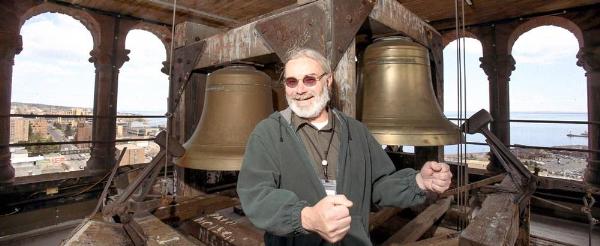 (I am also duplicating this article to our "Stories and Interesting Facts Page" to permanently preserve it for the future.)
Our old clock has had a good keeper for over 50 years. Meet John Hoban, one of the Keepers by CLICKING on John's name. Thanks to Terry Swor for finding this and passing it on to us. He notes "My brother Ron (Class of 58) in Atlanta sent me a link to an article about the clock tower at Central High. If you click on the article link (just click on John Hoban's name above), you will get a video pop-up about the one of the people who has attended to the clock mechanism over the last 50 years and a tour of the tower."
Be sure to also click on the individual pictures for more interesting stuff. Besides a fine video tour, there are individual pictures with captions, and paragraphs that present some information for which you may have never been acquainted.
Thanks Terry Storm of 1943 from Frank Cooper  Editors Note: In the early years, the bus company used to publish a 4.5" by 6" - 4 page newspaper for people to read as they rode the bus.
An interesting note is that this is around the time the Duluth-Superior Transit Co. was switching from the overhead electric "trolley cars" to "gas buses". (Note the two drawings at the top of page 1. On the left is a diagram of an electric trolley and on the right is a diagram of the new gas bus.)
Frank Cooper brought this copy to me at the reunion knowing it had a surprise ending. The Letter to the Editor signed C. A. Sorensen was written by my father. The Lake Walk   For those of you that haven't been back to Duluth for a long time or those that haven't taken the time, I highly recommend the Lakewalk. The Lakewalk is a 7.2 miles long paved trail along the shore of Lake Superior. It begins at the Aerial Lift Bridge in downtown Duluth and ends at 60th Avenue East. Certainly, you can walk what ever length you want, but personally I would start at the Ariel Bridge.
The walking trail traces the shore of Lake Superior, fronting the Duluth downtown area. Along the way you can take in the beauty of Lake Superior and the fascinating lure of a working port with foreign and domestic vessels sailing nearby. At the western end are the Duluth Entertainment Convention Center complex (including the Omnimax and Duluth 10 movie theaters), the Great Lakes Aquarium and the Bayfront Festival Park, where hot tunes sound out on cool summer nights. In-between are the Canal Park entertainment district, the icon Aerial Lift Bridge, and sculptures representing Duluth and its sister cities in Sweden, Russia and Japan. As you continue east you will pass the Northland Vietnam Veterans and Korean War Memorials, Leif Erickson Park and the Rose Garden with 2000 rose bushes of some 99 varieties and numerous trees, shrubs and other flowers.
Editor's Note: Personally, I wouldn’t take the walk without stopping at one of Duluth’s best malt shops, The Portland Malt Shoppe. Also, I much recommend the surreys with the fringe on top bike rentals. They hold 2 to 4 people. Remember WFTV Channel 38? 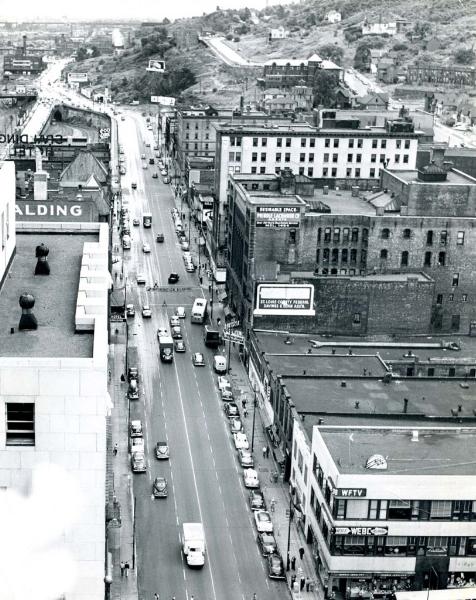 At the corner of Superior and Fourth Avenue West, in the building occupied today by Beacon Bank and other offices, is the former home of WEBC-560 AM (lower right hand corner). As you can see from the sign, back then it was an NBC radio affiliate (today it carries ESPN sports radio).
That’s cool, but it’s not the really unique aspect of this shot. The most interesting part is the sign right above, for WFTV Channel 38 – Duluth’s first television station.
Never heard of it? That’s because it was around for a very short time. According to a history of WEBC (which shared office space with the new TV station), WFTV went on the air in 1953 (at channel 38, it was a very early “UHF” station). It carried programming from the ABC, CBS, NBC and DuMont networks. You can see it on a list of channels included in TV Guide in January 1954.
After two more stations – channels 3 and 6, then KDAL and WDSM, now KDLH and KBJR – started broadcasting in March 1954, WFTV quickly went out of business. A station in Orlando, Fla later picked up the call letters.
Editors Note: Although this information may be true, the original studio was directly under the tower (the only tower on tower hill that is self supporting). I remember many times, as a kid, climbing that tower and going up to see their broadcasts (the back door of our house was at the base of tower hill).
When WDSM-TV started, they built right next to the Channel 38 building. Their broadcast studios were located behind two garage doors on the front of the building. On hot summer nights they had to open the garage doors to cool the studio down. As kids, we would go up and watch the broadcasts from their driveway. When Dottie Becker became the household word in daytime Duluth TV, I believe a fancier studio was made for her. Many of the highly visual local personalities went from Channel 38 to WDSM Channel 6. Do you remember Herb Taylor (Mr. Tolliver's Travels), Ray Paulsen (Mr. Toot-the Clown), Jack MacKenna (Captain Q)...?
What do you remember? Share your stories that have universal interest to classmates.
Remember Albert Woolson? 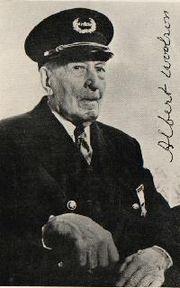 Recently, Frank Buckles, the last surviving soldier of WWI has passed away. God Bless his soul. He is being honored in Washington DC.
This triggers a memory to me and perhaps to others that attended elementary school at Nettleton in Duluth. I remember that we made birthday cards for Albert Woolson. He was the last surviving Union soldier from the Great Civil War. The whole school in classes would then be walked to his house, a few blocks away, and we'd sing for him and he would come out and say a few words. He was a happy and lovable old soldier....beloved by all.
Albert Henry Woolson (February 11, 1847 – August 2, 1956), was the last surviving soldier of the Civil War. He was also the last surviving Civil War veteran on either side whose status is currently undisputed. He enlisted as a rifleman but served as a drummer and bugler with Company C, 1st Minnesota Heavy Artillery. In late 1864, the regiment was part of the Army of the Cumberland in Tennessee. Woolson was discharged as a Private on Sept. 27, 1865.
http://www.vets-hall.org/stories/civil-war/albert-woolson
Editors Note:I tried to confirm today the relationship between Mr. Woolson and classmate Bob Nylen. It turns out he wasn't related to Bob, but was Bob's next door neighbor. You'll have to ask Bob about the thousands of dollars Albert gave Bob. That is a story on its own. I also fondly remember these annual trips to Mr. Woolson's home. It was quite an experience, not recognized fully then, but a wonderful memory now.
Patrick (Pat) Kennedy+ April 1961....and You Were There! 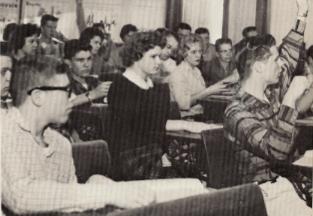 Bob Robinson has 8mm footage of our class in typical classroom activities and going to lunch. He has transferred it to video and posted it on U-tube. It loses a little clarity in the process, but it is still fun to watch. From time to time you will want to pause the video to get to see more detail or just to slow the pace down.
“The girl at the end is Beverly Anderson, who may still be in the Duluth Area. I last saw her about 20 years ago and do not know if she is still alive or not. She was a Junior at the time I was a senior. “ Bob Robinson
To take a peek at the video just click on the title below:
"1961 Typical Class Day"
or copy and paste the web site below into your browser:
http://www.youtube.com/watch?v=rLFfv6UivNY Duluth - What Do You Remember?  We thought you might enjoy this old photo. Although it was taken in 1969, it is pretty much the same as downtown Duluth when we graduated in 1961. Stores from left to right, if I can read them correctly include: Three Sisters, F. W. Woolworths, Jupiter*, Lee Fabrics, Swor Shoes (I think) and of course Glass Block, where many of you will remember having your feet X-rayed to see if your shoes were the correct size. It is a wonder we didn’t all die of over X-rayed feet.
* Just a side note: Jupiter replaced S. S. Kresge's 5¢ & 10¢ store, few people know that Sebastian Spering Kresge also started Jupiter stores and eventually changed the corporate name to K-mart.
Fun things to notice include:
- Hundreds of people shopping downtown (no malls)
- Christmas shopping before the first snow?
- Most women wearing shirts and dresses (no pants allowed)
- Those old style buses
- Street lights and stop lights have been significantly updated since 1961
- Four asphalt lanes of traffic in downtown Duluth (all two lane brick now)
- Parallel parking (diagonal now)
- Department store display windows
- Are some of those women wearing “Kickerinos”?
- Other women wearing knee high Go-Go Boots (Nancy Sinatra's 1966 hit, "These Boots Were Made For Walking")
- Policeman directing traffic and shoppers (not shown the “Duluth Parkettes” with skirts, a smile and a parking ticket book – started in 1957)
- Women wearing scarves
- Men wearing “Fedora Hats”, the fedora hats died a slow painful death after JFK chose not to wear a hat to his inauguration in 1961.
- I think that is Arde Stabs “Crusin’ Chicks” in the car on the lower right (:>)
Let me know what you find and I will add it to the list.
Ken Sorensen
krjt2@mchsi.com
218.722.9303 Twelve Story Tall Christmas Tree New at Bentleyville Tour of Lights!  Bentleyville Tour of Lights was pleased to announce the addition of a twelve story (120 feet) tall Christmas tree to their Bayfront Festival Park display this year. As tall as Downtown Duluth's Medical Arts Building and rising more than twice the height of New York City's famous Rockefeller Center Christmas tree, this steel fabricated tree covered with 50,000 music synchronized LED lights is located in the center of Bayfront Park.
Check out YouTube sites - http://www.youtube.com/watch?v=Gy4TgbBYjKU&feature=related or http://www.youtube.com/watch?v=tKhvvKBnCGs&feature=related
The Bentleyville tree was constructed by volunteer iron workers at the Iron Workers Local 512. Iron workers welded together 17 tons of iron building the tree to the height of 120 feet. This tree was made possible through the generosity from Krech Ojard, Iron Workers Local 512, Dynamic Structural Steel LLC, Northern Industrial Erectors from Grand Rapids, CR Meyers from Coleraine, Shelton Excavating, St. Joseph Equipment, JP Concrete, Twin Ports Concrete Pumping and Arrowhead Concrete.
Showcased as the "Tallest Christmas Tree in the United States", the bentleyville tree was the premier attraction as people experienced the magic of nearly 3 million lights illuminating the Bayfront Festival Park from November 20th through December 26th, Sunday through Thursday 5:00-9:00 PM, Friday and Saturday 5:00-10:00 PM. Admission was free. http://www.bentleyvilleusa.org/NewsRoom.aspx CLYDE IRON WORKS (1889-1986 or not!) Part 1  by: Shirley Johnson (Auble)
Now here is a great history lesson for all you history buffs like me, and if you aren’t then read from the bottom up to get to the gist of this story. Clyde Iron Works actually started out being Clyde Iron Company on Oct 15, 1889. Five men started this company that was located at 304-308 Lake Avenue South, Duluth. By 1894 the company was having financial difficulties and in April 1899 Northwestern Mfg. Co, purchased the company. From the beginning, the principal men associated with Clyde Iron and men in the various companies linked to Clyde Iron overlap and some company names are similar. The name “The Northwestern Manufacturing Company of Duluth, MN” continued to be used until June 10, 1901, when stockholders voted to amend some articles and name the company “Clyde Iron Works”. The company was sold and or merged many times until 1986 when the Duluth operation closed and was moved to St. Paul, MN.
CLYDE IRON WORKS (1889-1986 or not!) Part 2 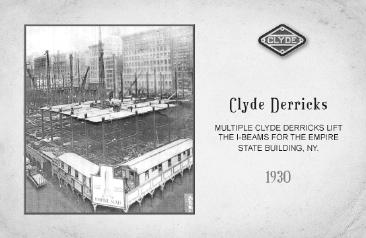 by: Shirley Johnson (Auble)
Clyde Iron Works started out as a foundry and smelting of iron and other metals, and manufacturing engines, boilers and machinery of all descriptions, forgings of all kinds, castings of iron, steel, brass and other metals. In 1901 due to the evolution from hand to mechanical methods, a steam log loader was designed and manufactured. The inventor was a Duluth lawyer, John R. McGiffert, who became an officer in the company. It was patented and was called The McGiffert Log Loader. In 1908 the company moved from Lake Avenue South to a number of acres at 29th Ave W. and Michigan St. where it remained through 1986 irrespective of its many, revolving, out-of-state parent firms.
By 1935, Clyde Iron’s hoists, derricks, and Whirley cranes (called Whirley because they can whirl or be rotated 360 degrees) were used in many projects including Boulder Dam, San-Francisco-Oakland Bridge, Grand Coulee Dam, the Panama Canal, New York City’s Empire State Building, Radio City Music Hall and United Nations building, and the Golden Gate Bridge. During World War II the company’s contributions were many. Clyde’s entire facilities and its 400 workers worked 24 hours a day, and were awarded the Army-Navy “E” for outstanding machine production, engineering ability, efficiency and for the high character and workmanship of their products. Who Knew!! I encourage you to go to the Web site at www.d.umn.edu/lib/nemhc/guides/s2365.htm and read all of the accomplishments the Clyde Iron Works achieved. I was very impressed and I just know that some of our grandfathers and fathers worked there at one time or another.
Duluth's Best Kept Secret 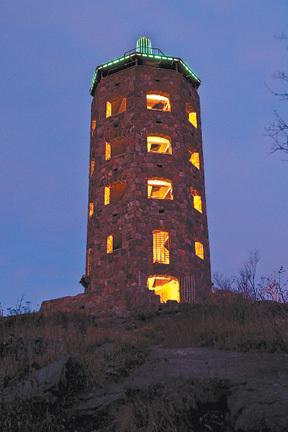 Something New Has Been Given to Something Old In Our Town
by Shirley Johnson (Auble)
I’m speaking about Enger Tower as I am sure that most of us have been there as teenagers a time or two. By June of 2011 there will be LED lamps shining on each of the faces of the octagonal tower at night. The high-tech lighting system will be controlled by computer software that can make adjustments and even change the hue. The system boasts a palette that would provide the city with a host of creative options. The Rotary Club No. 25 of Duluth wanted to do something special on their club’s centennial and have donated $100,000 to bathe Enger Observation Tower in light.
According to the Duluth City Architect Terry Groshong, another $549,000 will be spent on repairing the stonework, the towers inside lighting and also the grounds around the tower. There is a Japanese garden including a pavilion and a peace bell from Duluth’s sister city in Japan. It’s a great place for a picnic as there are picnic tables, Grills to cook on and rest rooms. There are great views overlooking the city and the harbor. The Superior Hiking Trail also wends its way around the area.
The tower plus 600 acres of land were a posthumous gift to the city from Bert J. Enger, a native of Norway who immigrated to Duluth and made his fortune selling furniture. In accordance with his wishes, Enger’s ashes were placed in a vault that was incorporated into the tower. The 1939 opening of the tower was attended by Norwegian royalty, including Crown Prince Olav and Princess Martha, who presided over its dedication.
Next summer when you drive into town coming down Thompson Hill and see the Aerial Lift Bridge all lit up, look upward and you will also see Enger Tower all lit up as well.
For more pictures go to: http://horticulture.cfans.umn.edu/gardens/gardens-northern/Enger-Tower-Park.htm 
Enger Park's Peace Bell and Gardens
Commencement Announcement Dale Hanson 's mom came up with a copy of our Commencement Announcement that he felt would be fun to share. I have tried to develop the clarity as much as I can, but it is impossible to read on the web site due to the small type size. We will try to reproduce it in Reunion Book. Thanks Dale.
Just a Side Note: There are 391 names listed on the Commencement Announcement, however we keep in touch with 446 classmates. The reason for the difference is varied; some dropped out of school, some joined the service while others had to move out of town. What ever the reason, we are proud of the fact that they still want to keep in touch with our class and continue to be an important part of us. Cannon - Editor's Note 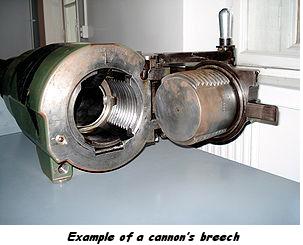 I recently talked with Reverand Lloyd Mattson (Old Grandpa Lloyd) www.LloydMattson.com. He was a student back in 1938 and a witness to this fiasco. As he tells it, “The end of the cannon had been sealed up for years, there was no way to fire this cannon with a projectile. What did happen was that the back end of the cannon (the breech) was functional (see the attached picture).”
“The breech was loaded with some unknown material, gun powder and the delayed action fuse was lit. When the cannon went off it blew out the back of the cannon and that is how the 15 windows were blown out of Old Central.”
This is up for grabs. Ask your parents and grandparents. Cannon Part 3 - And now ... The rest of the Central cannon story!!  Last week I traced the history of a Spanish-American War cannon perched on display for nearly half a century outside old Duluth Central High School, at Lake Avenue and East Second Street. Drawing on numerous historical documents, I reported that the cannon met a rather unceremonious end: It was sold for scrap in 1942 during a desperate plea for metal and other building materials for World War II.
"We sent that good old landmark, the cannon, off to war," Central students mused in their 1943 "Zenith" yearbook. But was that really what happened to the cannon? A couple of readers aren t so sure. "You missed the drama of this story," long-time Duluth resident Ron Kyllonen wrote me in an e-mail. He recalled a photo in the Duluth Herald, published after World War II, of the cannon still in the corner of a scrap yard in what s now Canal Park. A stack of cannon balls sat next to it in the picture.
"It never made it to the war," Kyllonen claimed. "The cannon sat in Harvey and Sid Karon s scrap yard [at Northwestern Iron and Metal], about where Grandma s is now. It wasn t until the 50s that it was cut up. & Most anyone who was in business down on [South First Avenue East] during that time would recall it. My brother-in-law had a welding supply business down there at the time, before the grand expansion took place."
Does anyone else recall seeing such a photo? It s certainly not on file with other news clippings. Those old stories are rich in detail about the cannon s arrival in Duluth 1899 after it was plucked from the Spanish cruiser Oquendo. The Oquendo was one of four warships that boldly but unsuccessfully attempted to run an American naval blockade of Cuba on July 3, 1898. Within hours, the Oquendo lay beached and in flames six miles west of Santiago Harbor.
(Additional Note: The Duluth City Council asked for a memento from this event and was granted the aquisition of the ship's cannon. There was only one catch--the city must pay for all transportation costs for the cannon. The city paid the price, and the 17 foot 6 ton cannon was to have led a serene life near the front of Old Central.)
For 43 years the cannon was a fixture at Central. Students posed for pictures next to it, decorated it for big games and guarded it late into the night to prevent rival schools from decorating it with their enemy colors.
Duluthian Tim Kaspari also questioned the melted-down-for-war story. But his suspicions are based on a story far different the one Kyllonen s claims. "I was born in 1948 and raised in Duluth," Kaspari wrote. "I attended Morgan Park [High School and] I vividly recall a cannon in the front of the school. And it seems to me the barrel of it was filled with artifacts and sealed up and buried in the front of either the school or courthouse. It was to be dug up after 100 years, my guess is around 2066. I will research this; however [I] believe this to be true."
Could the Spanish-American War cannon, after being removed from Central and spending time in a scrap yard in what is now Canal Park, have wound up in front of Morgan Park High School? Could there have been a second cannon? Is there some other plausible explanation for these remembrances? Anyone able to shed some additional insight should feel free to contact me.
Also reported in last week s cannon column was that on Oct. 3, 1938, the cannon s barrel was stuffed with beer bottles, horseshoe calks, short pieces of iron, stones, dampened paper and gun powder and that at 9:35 p.m., a fuse was lit, leaving Central shaking from a deafening blast, 16 of its windows shattered. "There was speculation about an attentive Central chemistry class, but no one ever was caught," I wrote. But I was wrong.
Alyssa McLaughlin, 15, told me during the past week that her grandfather, John C. McLaughlin, and his buddy, Bill Jones, were the ones who lit the cannon and got caught. Their parents were made to pay for the broken glass. "My grandfather was a chemistry student, but they bought all the supplies at a local hardware store and got the information for the mixture for the blast at the Duluth Central [High School] library," she wrote. Her grandfather died in January, and the cannon story was one of many of "all of the crazy things he would do when he was younger" shared at his funeral, Alyssa said.
"I would also like to let you know I am a Trojan and at this point will be the last graduating class of Duluth Central High School," she wrote. "I think this article ("Old Central cannon provided a blast in the past," July 27) made me think of the loss of my grandfather. So thank you very much." Thank you, Alyssa.
Posted by: cfrederick on 8/01/2008 at 4:45 PM Cannon Part 2 - Where were those cannon balls again?  An apology to Ron Kyllonen, who questioned a report in a column a couple of weeks ago that the Spanish-American War cannon displayed outside old Duluth Central High School was scrapped and melted down for World War II. Kyllonen recalled a newspaper photo, published after the war, of the cannon still in a junk yard. Next to the cannon in the picture, I reported, was a pile of cannon balls.
But that’s not where the ball were, Kyllonen pointed out to me in an e-mail this morning. I misunderstood him. "I did not imply the cannon balls were in the scrap yard," he wrote. "They were alongside the cannon in front of Central [and] used to be painted with Denfeld colors periodically. &There must be an old-timer at Duluth Spring [who’d know more about what happened to the cannon]. Just think: This is only 50 years ago, and books of the New Testament were written decades to hundreds of years after the fact and are accepted without question."
Again, sorry to Ron. Anyone with additional information about the cannon --- as Kyllonen suggests there should be --- can feel free to contact me.
Posted by: cfrederick on 8/04/2008 at 1:57 PM Cannon Part 1 - Fire Central's cannon and then what do you do? 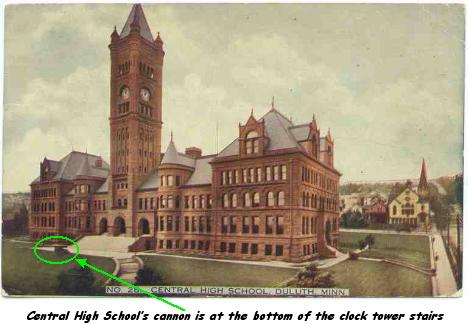 So what do you do after illegally firing off a historic cannon displayed as a yard ornament outside a downtown Duluth high school? If you were the two Duluth Central students who lit off the Spanish-American War cannon on Oct. 3, 1938, outside old Central High at Lake Avenue and Fourth Avenue East you go get ice cream.
Herbert Olander of Apple Valley, Minn., claims John McLaughlin and Bill Jones did just that after learning through research inside the Central library how to fire the long-dormant cannon."After lighting the delayed fuse McLaughlin and his buddy went downtown to the Bridgeman's on Superior Street to eat ice cream and await the blast," Olander wrote to me in an e-mail after reading a cannon chronology over the past couple of weeks on the pages of the News Tribune and on this blog. "Everyone knew that it was him because he was a gun nut," Olander continued. "I heard the story in the early 1950s at the Northwestern Gun Club. I am now 76 years old."
Olander's note verified as true the story told on this blog by McLaughlin s granddaughter, now a Central Trojan herself. However, Olander was unable to verify Ron Kyllonen's claim that the cannon wasn't actually melted down for World War II, as has regularly been reported over the years. "Ron Kyllonen was my classmate at Denfeld and I knew him well," Olander wrote. "I cannot vouch for his story but it also is probably true." And the tale of Central s cannon continues. Feel free to weigh in by leaving a comment.
Posted by: cfrederick on 8/06/2008 at 5:23 PM How Big Was Our Class? With the advent of the airbase closing and other drops in population in the city, our class saw a considerable change in its enrollment. Early on, in our 50 years of reunions, our reunion organizers Sonny Lorentzson and Roger Hanson with committee approval made a decision that classmates that moved before graduation or were to graduate with us, but didn’t for a variety of reasons, should not be left out just because they didn’t walk across the stage. This is especially true for those that have wanted to keep in touch with the class.
Our Central Class of 1961 started with 554 classmates in the fall of 1958, ended with 562 in the spring of 1959. By the spring of 1960, we were down to 476 and our commencement announcement lists 391 graduates.
We have been maintaining 447 classmates that have either graduated with us or that wanted to continue a relationship even though they had to move away from Duluth, changed high schools for various reasons (moved within the city, went to Cathedral) joined the service of their country, graduated late or dropped out of school.
If you know of anyone that we should be keeping track of, please do not hesitate to let us know. Duluth Central High School Timeline
1890’s
1892 (June 11) Central's corner stone put in place
1892 (October 18) Central dedicated
1892 Principal, Mr. E.F. Lohr
1894 First Yearbook, the "Tiger" published 1897 Principal, Mr. John Loman
1899 (July 1) Cannon mounted at Central
1900’s
1900 Principal, Mr. C.A. Smith
1900 Pres. McKinley visits Central
1910’s
1911 Principal, Mr. Young
1914 Greenhouse added
1920’s
1922 School Newspaper, "Spectator," began
1923 More classrooms added
1924 Principal, Mr. A.M. Santee
1925 Freshmen class moved to Washington Jr.. Lunchroom added in basement
1926 North wing added with gym facilities
1930’s
1938 (October 3) Canon fired off by two Duluth Central students
1938 Garages replace greenhouse
1939 Principal, Mr. G.A. Beck
1939 Wooden floors replaced
1940’s
1942 The school cannon is removed (said to have been scrapped for war use)
1950’s
1954 Richard Nixon makes a campaign stop at the school.
1955 First Helen of Troy, Marlene Stewart, is crowned.
1960’s
1963 (October 12) Past Graduate Dr. Robert Gilruth, from NASA visits Central
1963 Cafeteria ceiling collapsed -nobody harmed
1965 Principal, Dr. E.J. Duffy
1967 Gymnasium roof blows off in blizzard
1970’s
1970 Work begun on the new Central building
1971 New Central building dedicated
1972 Classroom walls added to new building
2010's
2010 (June 8) Last graduating class from the "New" Duluth Central High School
2010-2011 - Duluth Central & Denfeld merge as Duluth Denfeld Hunters @ Duluth Central site while Denfeld High School undergoes major remodeling.
2011 - Duluth Central High School building will be officially closed
Old Central  The Historic Central High School in Duluth, Minnesota was built in 1892 of locally-mined brownstone at a cost of $460,000. It features a 230 foot clock tower with chimes patterned after Big Ben in London; the clock faces are each 10 1/2 feet in diameter, overlooking the Duluth harbor. Architectural details such as gargoyles are the work of George Tharna. In 1972 the school board ceased using the building for classroom instruction, possibly because the hungry boilers would burn up to 8 tons of coal per winter day. The Central Preservation Committee and other interested citizens saved the building and created an 1890s classroom museum within the structure. Central team of 1961 - Minnesota's best - hits 40th (Now 50th) anniversary - Part 1 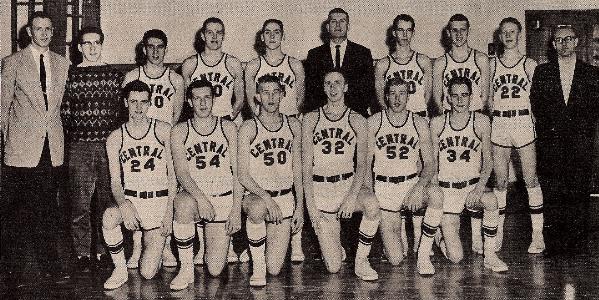 "A"Team BACK ROW: Coach S. Moe, Mgr. Ardy Stabs, D. Cohen, Wally Paschke, Roger Hanson, Coach J. Hastings, L. Stevens, Neil Nordvall, K. Johnson, Coach T. Brayden. FRONT ROW: B. Cobb, C. Anderson, Terry Kunze, W. Lundsten, Dan Howard, Chuck Bradburn
jwgilbert.com John Gilbert
It was obvious to Jim Hastings, the basketball coach at Duluth Central, that a special group of athletes would be coming up as seniors at Central in 1960-61. His suspicion was confirmed, when the group rushed through a perfect season, sweeping all challengers aside and going all the way to the state championship game before finding a true test. Forty years ago this weekend, arguably the best basketball team in Minnesota history brought the state basketball title home to Duluth.
The Trojans marched through the state tournament field at Williams Arena to finish a perfect 27-0 season with one of the most scintillating championship games in the tournament's history, a 51-50 victory over Bemidji.
Hastings took nine Central teams to state tournaments, winning titles in 1961, 1971 and 1979, finishing second three other times, and never playing a consolation round game, because the Trojans never lost a first-round game. In 1986, the year he retired, Central took a 26-0 record to the tournament final but lost to Bloomington Jefferson 52-51 in the title game. Still, the '61 team stands out, in basketball annals, and in Hastings' razor-sharp memory.
"Of all the sports teams in Duluth history, I'm proud of the fact that we were the only team in any sport, ever, that went through the whole season undefeated," said Hastings. "That's in all team sports."
Center Dan Howard wasn't a shooter, but at 6-foot-3, he was a solid rebounder, and he took more glee in firing crisp, no-look passes to set up teammates for easy chances than in merely scoring himself. Chuck Bradburn was a lean, lanky forward who could contribute points and rebounds as well. Chet Anderson, only a sophomore, was a solid 6-foot-2 and 220 pounds who was destined for big-time football, but who had a soft-touch jump shot from the corner that was so consistent he'd lead the team in scoring.
But the magic was at guard, where Terry Kunze was the enigmatic star with his angular 6-3 height, off-cadence stride, and ability to dribble the ball through his legs when few but Boston Celtics star Bob Cousy was doing such a thing, and who could shoot from inside with either hand, and from outside with a deadly touch. The other guard was Roger Hanson, less flashy, less flamboyant than Kunze, but a skilled ball-handler who had the prettiest jump shot ever seen Up North -- or south, east or west, for that matter.
"Those two were the best guard tandem, ever," said Hastings.
The bench strength was led by Neil Nordvall, Wally Paschke, Dan Cohen, Bill Lundsten and Brian Cobb, and they got a lot of experience, because Hastings enforced his own rigid brand of discipline. "I never had a team score 100 points, ever," said Hastings. "I didn't believe in it."
While the scoring could come from anywhere, it came mostly from Anderson, and then from the outside marksmanship of Hanson and Kunze. That, of course, predated the 3-point line. Kunze might score on some dramatic drives, twisting, changing hands and spinning the ball up off the backboard and in. But he might just as surely shoot from long range, where Hanson was. Rarely did the starters see much action in the fourth quarter.
In order to push the players, he practiced some things that he never planned to use, such as moving Kunze inside, where he could operate at center. "We practiced it all the time, just because I knew he could do it, and nobody could contain him," said Hastings.
The season flashed by, and some pretty good teams felt the sting of Central's brilliance. Central beat Two Harbors 70-44, for example, and beat Morgan Park 75-38, Grand Marais 93-38, East 74-30, Denfeld 78-29, Proctor 75-41, Silver Bay 87-42, Duluth Cathedral 88-52, but had stiff tests from Cloquet, and only beat the Lumberjacks 51-41 and 53-41. In the district tournament, East beat Cloquet 73-56, and in the Region 7 tournament, the Trojans swamped Pine City 93-44.
Kunze had a personal-best 28 points, Anderson 26, Hanson 24, Howard 21, Bradburn 20, Paschke 17. But none of them scored near their potential. "Any one of those three -- Hanson, Kunze or Anderson -- could have averaged over 30 points if I'd let them," said Hastings.
As they headed into the state tournament, Hastings had no idea what those players would become in later years. Kunze went on to star at Minnesota, while Hanson, who undoubtedly could have played Division I, stayed home to attend UMD on a scholarship. Howard went to Minnesota to concentrate on baseball, where he was a left-handed pitcher, and Anderson, who graduated two years afterward, went to Minnesota and played football, and later went on to play for the Pittsburgh Steelers in the NFL. They didn't need any validation, but Hastings recalls some accomplishments anyhow.
"Terry once made 14 of 15 shots against Michigan, which stood as a Big Ten record," said Hastings. "And Roger went 14-for-16 against South Dakota, which was a UMD record."
Hanson's shots were all from outside, while Kunze could hit from long range, but always mixed in some of those twisting drives as well. If Hastings had ever turned them loose -- or if there was a 3-point award in those days -- Central easily could have scored 120 points in some games.
"I remember when Terry was a freshman at Minnesota," said Hastings. "Freshmen couldn't play then, but Indiana had Jimmy Rayl, who was an outstanding scorer. So the Gophers had Kunze play the part of Rayl in a scrimmage, and Terry scored 58 points against the varsity. Then they played Indiana, and Rayl scored 58."
Hanson, who is a financial advisor at Swenson-Anderson in the Sellwood Building in downtown Duluth, recalled that one of the rare Central team of 1961 - Minnesota's best - hits 40th (Now 50th) anniversary - Part 2 jwgilbert.com John Gilbert
On the day before the team was leaving for the state tournament, Chuck Bradburn blew out his knee. "We were practicing the night before we were coming down," Hastings said. "Bradburn's knee popped, and he never even could play in the tournament. Fortunately, because we had used so many players all season, we put Wally Paschke in at Bradburn's position and didn't have any letdown."
Central crushed Danube and its superstar Bob Bruggers 74-52 in the quarterfinals. Chet Anderson hit 22 points, Hanson 17 and Howard 14. Danube coach Rod Black said: "That's the best high school basketball team I've ever seen." In the semifinals, the Trojans whipped Sauk Centre 75-53, as Anderson scored 26, Hanson 24 and Kunze 11. Then came the championship game, and 18,456 packed Williams Arena to see the clever Bun Fortier defuse the powerful Trojans from the outset with a pestering defense.
Kunze's playmaking was brilliant, but his shooting touch seemed to abandon him in the tournament, as all foes focused on covering him. In the fourth quarter, things looked bleak for Central, and the perfect season was on the line.
"We were down by 7 with four minutes to go," Hastings recalled. "I put Terry inside. We had worked him there all year in practice, but never tried it in a game. We knew they couldn't contain him."
Sure enough, Kunze threw a couple of left-handed hook shots up and Central came back, catching up from a final 46-40 deficit. Paschke hit a medium jump shot for his only two points of the game to put Central ahead. At 51-50, Bemidji played for a last, winning shot. You could slice the tension in the pressure-packed Williams Arena, with 18,000 fans screaming, mostly for the improbable upset-minded Lumberjacks. They worked the ball around to the baseline, and went for the shot with five seconds left. But Hanson leaped and got a hand on the ball, just long enough for the official to call jump ball.
"Roger tied up their shooter," Hastings recalled. "They went up for the jump ball, and Roger tipped it to Dan Howard. He threw the ball straight up in the air. Afterward, they asked him why he had done that, and Howard said that he knew the roof was really high in Williams Arena so he couldn't hit it no matter how high he threw the ball, and he knew there were only four seconds left, and that they'd be gone by the time the ball came down."
Brilliant. And correct. The buzzer sounded, and Central had won 51-50. Anderson scored 19 to finish as the tournament's leading scorer, Kunze had 14 and Hanson 12. Maybe the closeness of that final score has caused some observers to overlook how dominating that Central team was, but they know. And their Bemidji counterparts know. They held a 30-year reunion game at Grandma's in Canal Park 10 years ago. The Central guys took it seriously and won, something like 82-40. Neil Nordvall, the only other player beside Hanson still living in Duluth, went down to the gym and shot baskets every night to sharpen up for the game. Kunze was the same as ever, as was Hastings.
"We were ahead by 30, so I took Terry out," Hastings said. "He begged me to go back in. Finally, I said OK, you can go back in if you promise not to shoot. He did, so I let him go back in. He took the ball and dribbled the length of the floor and dunked it."
It's a different era now. Strategy and interwoven team play has yielded to street ball, and teams work on 3-point shooting because it's worth more, not because shooters are so gifted that they can hit from 22 feet with the same efficiency as 10. Maybe the clinics and summer camps have improved the level of overall play, maybe not. But they play in so many different classes that nobody can keep the teams straight nowadays. And they don't ever attract 18,000 fans anymore.
Anyone who watched the 1961 Duluth Central state champs perform, however, knows which team is the best of all time.
|